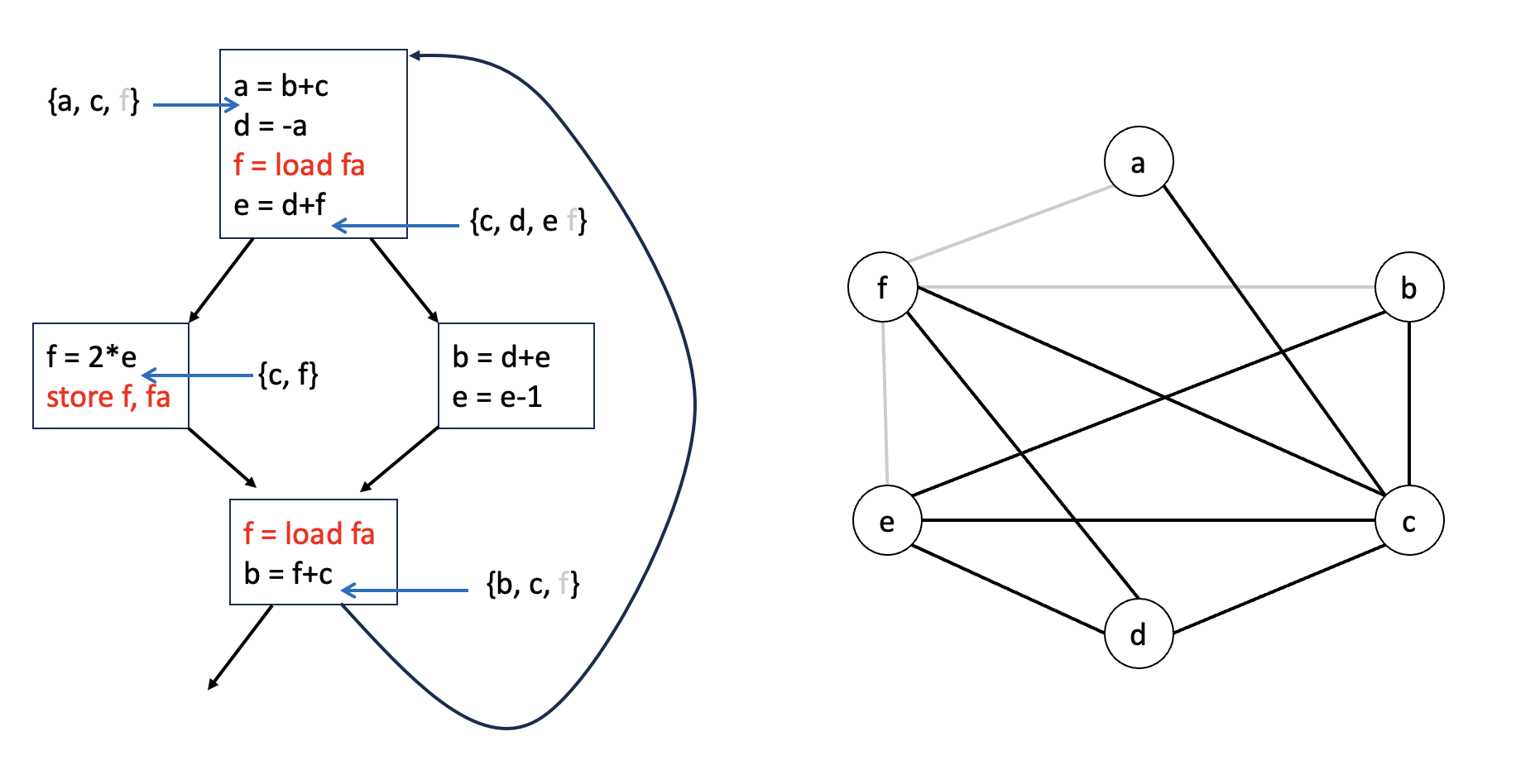Observations
v3 = v1 + v2 ---> r2 = r1 + r2
v4 = v1 + v3 r1 = r1 + r2
ret v4 ret r1
v1andv2interfere with each other. Thus, reg(v1)v2)
v1 ------ v2
v3 v4
Observations
v3 = v1 + v2 ---> r2 = r1 + r2
v4 = v1 + v3 r1 = r1 + r2
ret v4 ret r1
v1andv2interfere with each other. Thus, reg(v1)v2)v1andv3interfere with each other. Thus, reg(v1)v3)
v1 ------ v2
|
|
v3 v4
Interference Graph
v1 ------ v2
|
|
v3 v4
- Nodes: variables
- Each edge connects variables interfering with each other.
Solving Register Allocation Problem with Interference Graph
v1:r1 ------ v2: ?
|
|
v3 v4
Solving Register Allocation Problem with Interference Graph
v1:r1 ------ v2: r2
|
|
v3 v4
Solving Register Allocation Problem with Interference Graph
v1:r1 ------ v2: r2
|
|
v3:r2 v4: r1 or r2
Recall the Solution
v1:r1 ------ v2: r2
|
|
v3:r2 v4: r1 or r2
v1, v4 --------- r1
v2, v3 --------- r2
v3 = v1 + v2 ---> r2 = r1 + r2
v4 = v1 + v3 r1 = r1 + r2
ret v4 ret r1
General Strategy
- Two key questions
- Q1: How to construct the interference graph?
- Q2: How to assign the registers to the nodes in the interference graph?
Q2: How to assign the registers to the nodes in the interference graph?

Graph Coloring Problem

- Adjacent nodes must have different colors.
Graph Coloring Problem
- NP-complete problem
- Still, there are efficient algorithms that work well in special cases.
Idea

- Assume that we have 3 colors.
Idea

- Assume that we have 3 colors.
- If we can successfully color
Coloring by Simplification
- Input: Graph
- Algorithm
- Find a node
- Remove
- Recursively solve the problem with
- Find a node
Simplification Example (

Simplification Example (

- Stack: 5
Simplification Example (

- Stack: 5 2
Simplification Example (

- Stack: 5 2 1
Simplification Example (

- Stack: 5 2 1 3
Simplification Example (

- Stack: 5 2 1 3
Simplification Example (

- Stack: 5 2 1
Simplification Example (

- Stack: 5 2
Simplification Example (

- Stack: 5
Simplification Example (

- Stack:
Another Example (

Another Example (

Another Example (

- Pick a node and remove it from the graph.
Another Example (

- Continue the simplification process.
- Hope: {b, c, d, e} use less than 3 colors.
- This idea is called optimistic coloring.
Another Example (

- Continue the simplification process.
- Hope: {b, c, d, e} use less than 3 colors.
- This idea is called optimistic coloring.
- Does not work in our example and we need to spill
finto the memory.
Spilling

- Before each operation that reads a spilled variable
- After each operation that writes to a spilled variable
- store
- store
Spilling
- Which one to spill?
- a node that interferes with many other nodes.
- a node that is not frequently used.
Register Allocation
- Build the interference graph
- Apply the simplification algorithm
- If stuck, remove a node and try with the optimistic coloring.
- If the optimistic coloring fails, spill the node to the memory.
- This involves rewriting the code to load and store the value of the spilled variable.
- Repeat step 1.